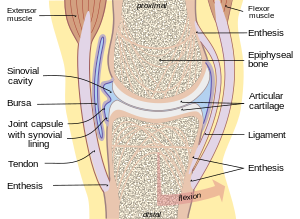Intra-articular
| Joint | |
|---|---|

Diagram of a typical synovial joint
|
|

Depiction of an intervertebral disc, a cartilaginous joint
|
|
| Details | |
| System |
Musculoskeletal system Articular system |
| Identifiers | |
| Latin | Articulus Junctura Articulatio |
| TA | A03.0.00.000 |
| FMA | 7490 |
|
Anatomical terminology
[]
|
|
A joint or articulation (or articular surface) is the connection made between bones in the body which link the skeletal system into a functional whole. They are constructed to allow for different degrees and types of movement. Some joints, such as the knee, elbow, and shoulder, are self-lubricating, almost frictionless, and are able to withstand compression and maintain heavy loads while still executing smooth and precise movements. Other joints such as sutures between the bones of the skull permit very little movement (only during birth) in order to protect the brain and the sense organs. The connection between a tooth and the jawbone is also called a joint, and is described as a fibrous joint known as a gomphosis. Joints are classified both structurally and functionally.
Joints are mainly classified structurally and functionally. Structural classification is determined by how the bones connect to each other, while functional classification is determined by the degree of movement between the articulating bones. In practice, there is significant overlap between the two types of classifications.
A facet joint is the joint between two articular processes between two vertebrae.
Structural classification names and divides joints according to the type of binding tissue that connects the bones to each other. There are three structural classifications of joints:
Joints can also be classified functionally according to the type and degree of movement they allow: Joint movements are described with reference to the basic anatomical planes.
Joints can also be classified, according to the number of axes of movement they allow, into nonaxial (gliding, as between the proximal ends of the ulna and radius), monoaxial (uniaxial), biaxial and multiaxial. Another classification is according to the degrees of freedom allowed, and distinguished between joints with one, two or three degrees of freedom. A further classification is according to the number and shapes of the articular surfaces: flat, concave and convex surfaces. Types of articular surfaces include surfaces.
Joints can also be classified based on their anatomy or on their biomechanical properties. According to the anatomic classification, joints are subdivided into simple and compound, depending on the number of bones involved, and into complex and combination joints:
...
Wikipedia
